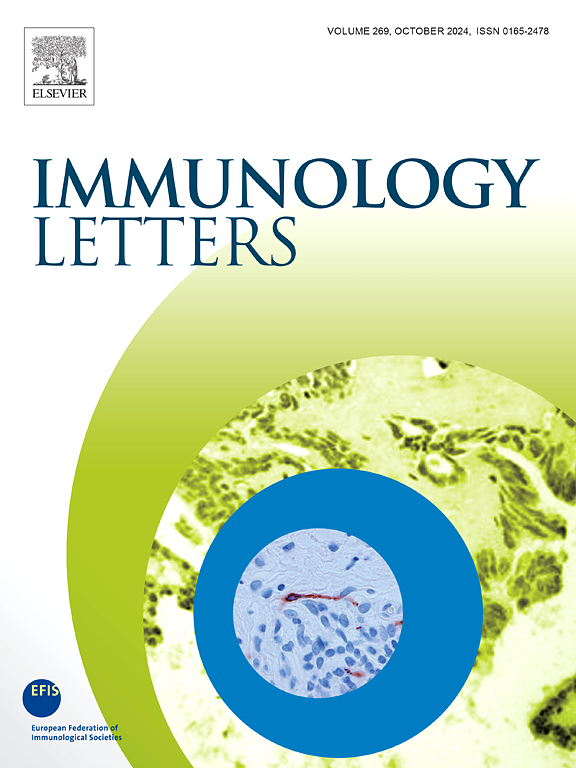Immune cells and functions in patients with restless legs syndrome
IF 2.8
4区 医学
Q3 IMMUNOLOGY
引用次数: 0
Abstract
Restless legs syndrome (RLS) is a sleep-related disorder, and some evidence suggests that inflammation contributes to its pathophysiology. This study aimed to investigate the relationship between RLS and immune cells.
Fourteen RLS patients, and 10 healthy subjects were included in the study. The percentages of T, B, natural killer (NK), natural killer T (NKT) and innate lymphoid cells (ILCs) were analyzed, along with intracellular levels of interferon-gamma (IFN-γ), interleukin (IL)-6, IL-10, and IL-13 in T, B and NK cells. Additionally, CD8+ T and NK cell cytotoxic activities were assessed using flow cytometry. Plasma levels of IFN-γ, tumor necrosis factor-alpha (TNF-α), IL-2, IL-4, IL-6, IL-10, and IL-13 were evaluated with bead-based soluble molecule assay.
Compared to healthy subjects, the ratio of ILC-1 subset and IL-13+CD4+ T cells were significantly increased in RLS patients, while the levels of ILC-2 subset were significantly decreased. When the NK cell cytotoxic activity of RLS patients was evaluated, it was found that the NK cell perforin levels were lower than healthy subjects. Plasma IL-13 levels were also significantly elevated in RLS patients compared to healthy individuals.
These findings suggest that both innate and adaptive immune responses may play a role in RLS pathophysiology. Alterations in ILC subsets, along with elevated IL-13, IL-10, and IL-6 levels, as well as NK and CD8+ T cell cytotoxic activity, indicate that immune dysregulation might contribute to the disease mechanism. Furthermore, the observed correlation between efficient sleep and immune markers highlights the potential role of immune system modulation in RLS management.

不宁腿综合征患者的免疫细胞和功能。
不宁腿综合征(RLS)是一种与睡眠有关的疾病,一些证据表明炎症有助于其病理生理。本研究旨在探讨RLS与免疫细胞的关系。本研究纳入14例RLS患者和10例健康受试者。分析T、B、自然杀伤细胞(NK)、自然杀伤T细胞(NKT)和先天淋巴样细胞(ILCs)的百分比,以及T、B和NK细胞内干扰素-γ (IFN-γ)、白细胞介素(IL)-6、IL-10、IL-13的水平。此外,利用流式细胞术评估CD8+ T和NK细胞的细胞毒活性。采用珠状可溶性分子法检测血浆中IFN-γ、肿瘤坏死因子α (TNF-α)、IL-2、IL-4、IL-6、IL-10和IL-13的水平。与健康受试者相比,RLS患者ILC-1亚群和IL-13+ CD4+ T细胞比例显著升高,ILC-2亚群水平显著降低。对RLS患者NK细胞的细胞毒活性进行评价,发现NK细胞穿孔素水平低于健康人。与健康个体相比,RLS患者血浆IL-13水平也显著升高。这些发现提示先天性和适应性免疫反应可能在RLS的病理生理中发挥作用。ILC亚群的改变,以及IL-13、IL-10和IL-6水平的升高,以及NK和CD8+ T细胞的细胞毒性活性,表明免疫失调可能与疾病机制有关。此外,观察到的有效睡眠与免疫标记物之间的相关性突出了免疫系统调节在RLS管理中的潜在作用。
本文章由计算机程序翻译,如有差异,请以英文原文为准。
求助全文
约1分钟内获得全文
求助全文
来源期刊

Immunology letters
医学-免疫学
CiteScore
7.60
自引率
0.00%
发文量
86
审稿时长
44 days
期刊介绍:
Immunology Letters provides a vehicle for the speedy publication of experimental papers, (mini)Reviews and Letters to the Editor addressing all aspects of molecular and cellular immunology. The essential criteria for publication will be clarity, experimental soundness and novelty. Results contradictory to current accepted thinking or ideas divergent from actual dogmas will be considered for publication provided that they are based on solid experimental findings.
Preference will be given to papers of immediate importance to other investigators, either by their experimental data, new ideas or new methodology. Scientific correspondence to the Editor-in-Chief related to the published papers may also be accepted provided that they are short and scientifically relevant to the papers mentioned, in order to provide a continuing forum for discussion.
 求助内容:
求助内容: 应助结果提醒方式:
应助结果提醒方式:


